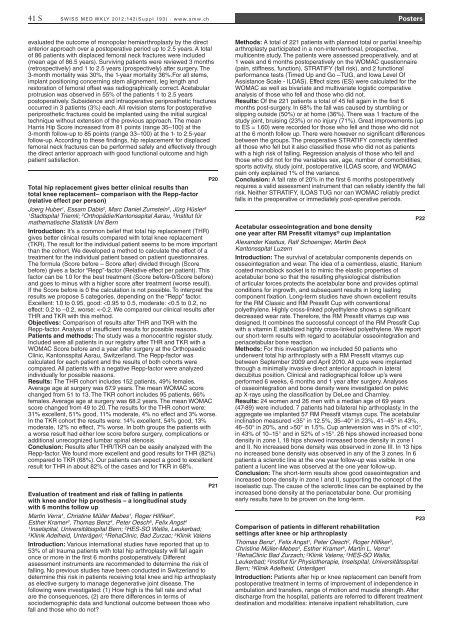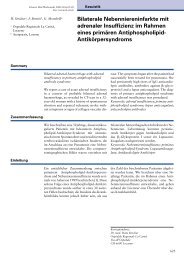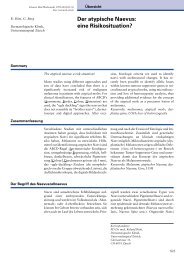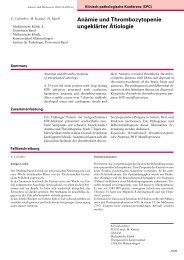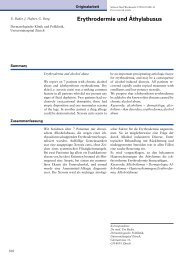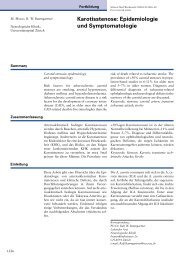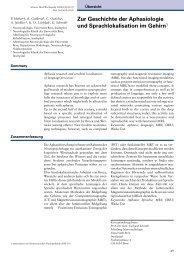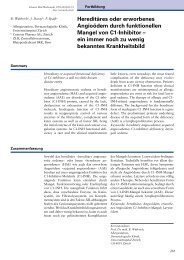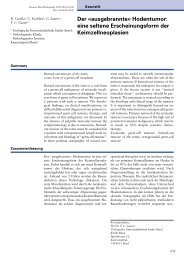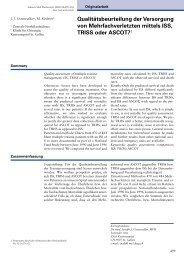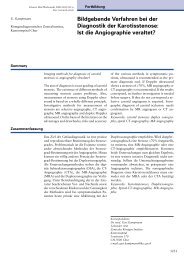SMW Supplementum 193 - Swiss Medical Weekly
SMW Supplementum 193 - Swiss Medical Weekly
SMW Supplementum 193 - Swiss Medical Weekly
Create successful ePaper yourself
Turn your PDF publications into a flip-book with our unique Google optimized e-Paper software.
41 S SWiSS Med Wkly 2012;142(Suppl <strong>193</strong>) · www.smw.ch Posters<br />
evaluated the outcome of monopolar hemiarthroplasty by the direct<br />
anterior approach over a postoperative period up to 2.5 years. A total<br />
of 86 patients with displaced femoral neck fractures were included<br />
(mean age of 86.5 years). Surviving patients were reviewed 3 months<br />
(retrospectively) and 1 to 2.5 years (prospectively) after surgery. The<br />
3-month mortality was 30%, the 1-year mortality 36%.For all stems,<br />
implant positioning concerning stem alignement, leg length and<br />
restoration of femoral offset was radiographically correct. Acetabular<br />
protrusion was observed in 55% of the patients 1 to 2.5 years<br />
postoperatively. Subsidence and intraoperative periprosthetic fractures<br />
occurred in 3 patients (3%) each. All revision stems for postoperative<br />
periprosthetic fractures could be implanted using the initial surgical<br />
technique without extension of the previous approach. The mean<br />
Harris Hip Score increased from 81 points (range 35–100) at the<br />
3-month follow-up to 85 points (range 33–100) at the 1- to 2.5-year<br />
follow-up. According to these findings, hip replacement for displaced<br />
femoral neck fractures can be performed safely and effectively through<br />
the direct anterior approach with good functional outcome and high<br />
patient satisfaction.<br />
P20<br />
Total hip replacement gives better clinical results than<br />
total knee replacement– comparison with the Repp-factor<br />
(relative effect per person)<br />
Joerg Huber1 , Essam Dabis2 , Marc Daniel Zumstein2 , Jürg Hüsler3 1Stadtspital Triemli; 2Orthopädie/Kantonsspital Aarau, 3Institut für<br />
mathematische Statistik Uni Bern<br />
Introduction: It’s a common belief that total hip replacement (THR)<br />
gives better clinical results compared with total knee replacement<br />
(TKR). The result for the individual patient seems to be more important<br />
than the cohort. We developed a method to calculate the effect of a<br />
treatment for the individual patient based on patient questionnaires.<br />
The formula (Score before – Score after) divided through (Score<br />
before) gives a factor “Repp”-factor (Relative effect per patient). This<br />
factor can be 1.0 for the best treatment (Score before-0/Score before)<br />
and goes to minus with a higher score after treatment (worse result).<br />
If the Score before is 0 the calculation is not possible. To interpret the<br />
results we propose 5 categories, depending on the “Repp” factor.<br />
Excellent: 1.0 to 0.95, good:


